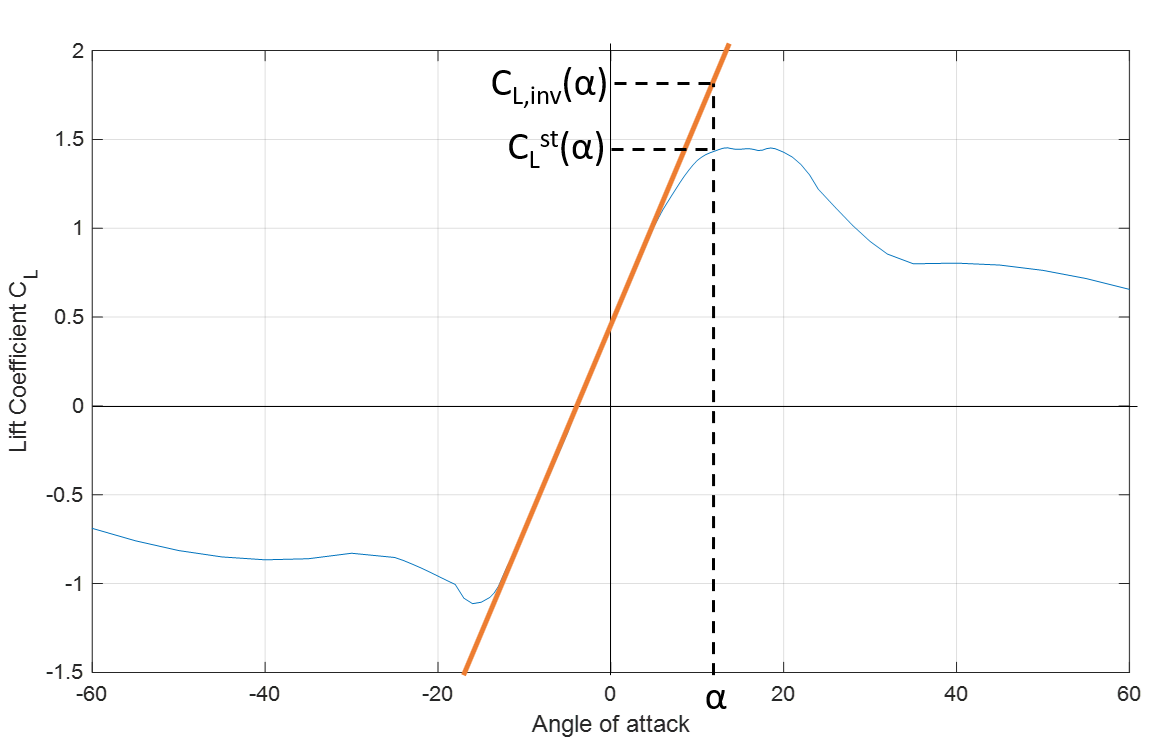Oye's dynamic stall model
This section explains how the lift coefficient CL is adjusted to account for dynamic stall effects following the work by Øye (1991a).
Note: the dynamic stall model is not relevant for cylinders
In this work, the dynamic stall is modelled through a so called separation function
$$f$$
such as $$C_L(\alpha) = fC_{L,inv}(\alpha) + (1-f)C_{L,fs}(\alpha)$$
(1)where
$$C_{L,inv}$$
is the lift coefficient for inviscid flow without separation and $$C_{L,fs}$$
is the lift coefficient for fully separated flow. In order to solve this equation, we first apply it to static conditions, such as$$C_L^{st}(\alpha) = f^{st}C_{L,inv}^{st}(\alpha) + (1-f^{st})C_{L,fs}^{st}(\alpha)$$
(2)$$C_L^{st}(\alpha)$$
corresponds to the value looked up in the polar and $$C_{L,inv}^{st}(\alpha)$$
is obtained by extrapolating the linear region of the lift curve, as illustrated below. Note that by definition, $$C_{L,inv}^{st}=C_{L,inv}$$
and$$C_{L,fs}^{st}=C_{L,fs}$$
. 
$$f^{st}$$
is given by$$f^{st}=\left(2\sqrt{\frac{C_L^{st}}{C_{L,inv}^{st}}}\right)^2$$
(3)Note that the theoretical upper limit for
$$f^{st}$$
is 1. If a higher value is obtained, then $$f^{st}=1$$
is taken. Once $$f^{st}$$
is calculated, $$f$$
is computed by assuming that it comes back to the static value following$$\frac{df}{dt}=\frac{f^{st}-f}{\tau}$$
(4)This forumla can be analytically integrated to give
$$f(t)=f^{st}(t)+f(t-\Delta t)-f^{st}(t)\exp{\frac{-\Delta t}{\tau}}$$
(5)where
$$\Delta t$$
is the time step of the simulation and $$f(t-\Delta t)$$
corresponds to the separation function at the previous time step. $$\tau$$
is a time constant taken as$$\tau = \frac{4c}{|W|}$$
(6)where
Once $$c$$
is the chordlength and $$W$$
is the relative velocity.$$f$$
has been determined, the next step to solve equation (1) is to calculate $$C_{L,fs}(\alpha)$$
and $$C_{L,inv}(\alpha)$$
. By reorganizing equation (2), we can express $$C_{L,fs}$$
as$$C_{L,fs}(\alpha)=\frac{C_L^{st}(\alpha)-f^{st}C_{L,inv}(\alpha)}{1-f^{st}}$$
(7)If
$$f^{st}=1$$
, then $$C_{L,fs}$$
is computed as $$C_{L,fs}(\alpha) = C_L^{st}(\alpha)/2$$
Once
$$C_{L,inv}(\alpha)$$
and $$C_{L,fs}(\alpha)$$
have been calculated, they are insterted in equation (1) to determine the lift coefficient.